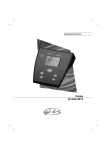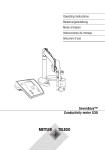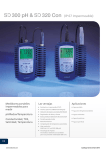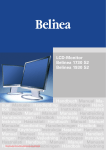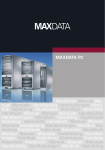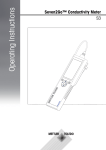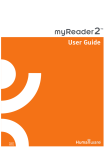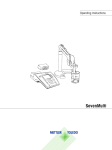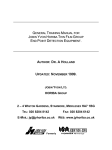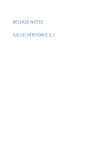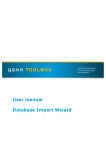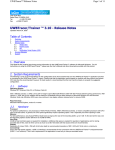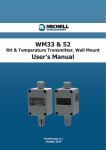Download b250 breed.indd
Transcript
Operating Instructions ProLine Conductivity meter B250 Contents Contents 1. Introduction 3 2. Safety measures 3 3. Description of the instrument 3.1 Display 3.2 Keypad 4 4 5 4. Installation 6 5. Sample Measurement 5.1 Conductivity measurement 5.2 TDS/salinity/resistivity measurement 5.3 Settings 7 7 7 7 6. Calibration 6.1 Settings 6.2 Calibration 9 9 9 7. Self-diagnosis 10 8. Battery operation 10 9. Error messages 11 10. Maintenance 10.1 Meter maintenance 10.2 Disposal 12 12 12 11. Accessories 13 12. Technical data 14 13. Quick guide 16 14. Appendix 14.1 Temperature correction factors f25 14.2 Conductivity standards 14.3 Practical salinity scale (UNESCO 1978) 14.4 Conductivity to TDS conversion factors 17 17 18 18 18 ProLine conductivity 1 2 ProLine conductivity Introduction / Safety measures 1. Introduction The QiS ProLine conductivity meter is an instrument offering far more than simple conductivity measurements without breaking your budget. It is an instrument with many advantages: - ProLine saves you time. The user interface is designed in such a logical way that you will no longer need to consult your user manual. - ProLine can be battery operated. Thanks to this option you can now easily move your instrument from one working area to another even if no power supply is available. - ProLine has additional advantages. Our Service Option provides regular equipment qualifications that will improve the reliability and accuracy of your instrument. 2. Safety measures Measures for your protection - Never work in an environment subject to explosion hazards! The housing of the instrument is not gas tight (explosion hazard due to spark formation, corrosion caused by the ingress of gases). - When using chemicals and solvents, comply with the instructions of the producer and the general lab safety rules! Measures for operational safety - Have the instrument serviced only by QiS Service! - Always wipe off splashed liquids immediately! The instrument is not waterproof. - Use batteries of the specified type only. Otherwise, proper operation cannot be guaranteed. - Exclude the following environmental influences: • powerful vibrations, • direct sunlight, • atmospheric humidity greater than 80%, • corrosive gases, • temperatures below 5 °C and above 40 °C, • powerful electric or magnetic fields ! ProLine conductivity 3 Description of the instrument 3. Description of the instrument 3.1 Display 1 Battery status 2 Auto-off override during battery operation 3 Data transfer to PC/printer 4 Reference temperature 5 Meter self-diagnosis Self-diagnosis indicator 6 7 8 9 10 11 12 13 4 Indication to press key Error index Conductivity/TDS/SAL/RES reading Auto/manual temperature compensation Endpoint stability/automatic endpoint Endpoint stability A Temperature Calibration standards & cell constant Temperature correction method Menu setting Self-diagnosis passed Automatic endpoint ProLine conductivity Description of the instrument 3.2 Keypad Press & release Press & hold for 2 seconds Meter On/Off. Auto-off override during battery operation. - Start or endpoint measurement - Return to measurement mode - Confirm setting - Store entered value Turn autom. endpoint on/off. / Start calibration. Switch between conductivity, TDS, salinity and resistivity measurement modes. Data transfer to PC or printer. Select calibration standard. Increase value during setting. Display cell constant during measurement. Start menu setting. Decrease value during setting. Measure Start meter self-diagnosis. ProLine conductivity 5 Installation 4. Installation 1. Unpack the meter, power adapter, electrode, electrode arm and other accessories according to the enclosed packing list. Keep the calibration certificate in a safe place. 2. Make sure the power adapter matches your local power supply. If not, please contact your vendor. 3. Connect the conductivity sensor. 4. Connect the power supply unit to the DC socket. DC power supply unit socket RS232 data output socket Conductivity sensor socket 6 ProLine conductivity Sample measurement 5. Sample Measurement 5.1 Conductivity measurement Place the conductivity sensor in the sample and press to start the measurement: The decimal point flashes. The display shows the conductivity of the sample. The automatic endpoint A is the meter‘s default setting. When the sensor output has stabilized, the display freezes automatically, and appears. The automatic endpoint algorithm is as follows: The measured conductivity of the sample may not deviate by more than 0.4% from the measured average conductivity of the probe of over 6 seconds. By pressing and holding the key, you can toggle between auto and manual endpoint mode. To manually endpoint a measurement, press , the display freezes, and appears. 5.2 TDS/salinity/resistivity measurement To perform a TDS/salinity/resistivity measurement, follow the same procedure as for a conductivity measurement. Press the key to switch between conductivity, TDS, salinity and resistivity measurement modes. 5.3 Settings 5.3.1 ATC/MTC Most conductivity sensors have a built-in temperature probe. When a temperature probe is used, the symbol ATC and the sample temperature are displayed. When the meter does not detect a temperature probe, it automatically switches to manual temperature compensation mode, and MTC appears. To set the MTC temperature, see 5.3.2 Menu setting. 5.3.2 Menu setting Press the key, the menu’s content appears on screen and the first item blinks: Set reference temperature Set temperature correction mode Set MTC temperatur Set TDS factor Use the or to start the setting. key to select a menu item. When the desired item blinks, press the ProLine conductivity key 7 Sample measurement Set reference temperature: When appears and the current reference temperature blinks, use the toggle between 25 °C and 20 °C. Press the key to confirm your selection. or key to Set temperature correction method: When appears and the current setting blinks, use the or key to toggle between key to confirm your selection. linear and nLF (nonlinear factor compensation). Press the If you choose the linear temperature correction method, the current temperature coefficient appears. Use the and keys to increase or decrease the value. Press to confirm your setting. Set MTC temperature: When appears, use the temperature for your sample. Press the 25 °C. and keys to increase or decrease the value of the key to confirm your setting. The default setting is Set TDS factor: When the current TDS factor appears, use the Press the 5.3.3 and keys to increase or decrease the value. key to confirm your setting. Data output If a PC or printer is connected, every endpointed reading is sent to the PC or printed via the RS232 interface. By pressing and holding the key, appears. The meter sends out a reading every second until it endpoints. 8 ProLine conductivity Calibration 6. Calibration 6.1 Settings When using the ProLine conductivity meter, you only need to do a 1-point calibration or enter a cell constant directly. key. The current calibration setting starts to blink. Press the Use the or key to select other items either above or below. When the desired option blinks, to confirm your selection. press If you choose to set the cell constant, the current setting appears and the first digit blinks. Use the keys to increase or decrease the value. Press the key to confirm your setting. To finish and your setting, follow the same procedure to set the next digits. Press to confirm your setting. The default setting is 1.000. 6.2 Calibration Place the conductivity sensor in a calibration standard and press . The ProLine conductivity meter automatically endpoints when calibrating. To manually endpoint, press . The meter displays and freezes the standard value. To return to sample measurement, press . Note - If you have entered the cell constant of your sensor and choose to use it for your measurement, you actually do not need to perform a calibration with a standard. If you press the key under this circumstance, the instrument shows the currently entered cell constant’s value instead of performing a calibration. - To ensure the most accurate conductivity readings, you need to perform a calibration regularly. ProLine conductivity 9 Self-diagnosis / Battery operation 7. Self-diagnosis Press and hold pears. and simultaneously until the meter’s self-diagnosis icon ap- The meter displays the full screen first, then each icon will blink one after the other. The final step is to check that the keys function. This requires the user‘s cooperation. blinks, press the corresponding key within 10 seconds. When the icon a. When b. When c. When d. When e. When flashes, press the flashes, press the key. flashes, press the flashes, press the flashes, press the key. key. key. key. When self-diagnosis is completed, a icon appears. If self-diagnosis failed, turn to "9. Error messages" in these Operating Instructions for the proper action(s) to be taken. 8. Battery operation The ProLine conductivity meter offers optional battery operation. Install 4 AA batteries in the rear of the meter. If the power adapter is disconnected, the meter is operated by battery and the icon appears. When the batteries lose power, the meter displays . During battery operation, the meter has an auto-off function. If no key is pressed during the next 10 minutes, the meter will automatically switch off to save battery power. To override the auto-off function, press and hold the key for 2 seconds until appears. 10 ProLine conductivity Error messages 9. Error messages Error 1 - Conductivity measuring value out of range Check if the sensor is properly connected and placed in a sample solution. Error 2 - Temperature measuring value out of range (–5...105 °C) Keep the sample temperature within the range. Error 3 - The measured calibration standard temperature is out of the range (0...35 °C ) Keep the calibration standard temperature within the range. Error 4 - In nLF temperature correction mode, temperature measuring value out of range (0...35 °C) Keep the sample temperature within the range. Error 5 - Self-diagnosis failed Repeat self-diagnosis and make sure that you press the correct keys while the blinking. If Err 5 still appears, call QiS service. ProLine conductivity icon is 11 Maintenance 10. Maintenance 10.1 Meter maintenance There are no user-replaceable parts in the meter or power supply unit. Do not remove the covers. The ProLine conductivity meter needs no maintenance except for an occasional wipe with a damp cloth. The housing is made of ABS/PC, which is attacked by some organic solvents, such as toluene, xylene and methyl ethyl ketone. It is good laboratory practice to wipe away any spillage immediately. Note To prevent static damage to the instrument, always disconnect the conductivity sensor from the meter before cleaning the sensor. 10.2 Disposal In conformance with the European Directive 2002/96/ EC on Waste Electrical and Electronic Equipment (WEEE) this device may not be disposed of in domestic waste. This also applies to countries outside the EU, per their specific requirements. Please dispose of this product in accordance with local regulations at the collecting point specified for electrical and electronic equipment. If you have any questions, please contact the responsible authority or the distributor from which you purchased this device. Should this device be passed on to other parties (for private or professional use), the content of this regulation must also be related. Thank you for your contribution to environmental protection. 12 ProLine conductivity Accessories 11. Accessories Order no. Power supply EU Power supply UK Power supply US QA8550X QA8560X QA8570X Swing arm electrode holder Printer Printer paper, pk/5 Printer cable QA854X QA8060X QA8070X QA8080X Conductivity standard 1413 µS/cm, 500ml Conductivity standard 12.88 mS/cm, 500ml Conductivity standard 111.8 mS/cm, 500ml QS950X QS951X QS1012 Conductivity electrode 4-pole, temperature sensor, epoxy Conductivity electrode 4-pole, temperature sensor, glass Through flow cell QC2260T QC2210T QA853X ProLine conductivity 13 Technical data 12. Technical data Conductivity measurement Measurement range Resolution Limits of error Selectable reference temperature Linear correction Nonlinear correction (DIN38404) Calibration standard Auto range 0.00 µS/cm…19.99 µs/cm 20.0 µS/cm…199.9 µS/cm 200 µS/cm…1999 µS/cm 2.00 mS/cm…19.99 mS/cm 20.0 mS/cm…199.9 mS/cm 200 mS/cm…500 mS/cm ±0.5 % of measured value 20 °C or 25 °C Yes Yes 1-point (84 µS/cm, 1413 µS/cm, 12.88 mS/cm) TDS measurement Measurement range Resolution Relative accuracy Adjustable solids factor 0.0 mg/L ... 500 g/L Auto ranging, same as conductivity ± 0.5% 0.4 ... 1.0 Salinity measurement Measurement range (ppt) 0.00 ... 80.00 Resistivity measurement Measurement range 0.00 Ω • cm ... 20 MΩ • cm Temperature measurement Temperature range Temperature resolution Temperature relative accuracy –5.0 ... 105 °C 0.1 °C ± 0.2 °C Display Liquid crystal Outputs RS232 serial, Baud rate: Data bit: Stop bit: Parity: 1200 8 1 none Ambient temperature: Relative humidity: Installation category: Pollution degree: 5 … 40 °C 5% … 80% (non-condensing) II 2 Ambient conditions 14 ProLine conductivity Technical data Size/weight 180 x 180 x 65 mm / 0.61 kg Materials Housing: Electrode stand: Membrane keypad: Power requirements The ProLine conductivity meter is supplied with an appropriate power supply unit: - USA: 120 V / 60 Hz, 10 VA, 9 V DC - Europe: 230 V / 50 Hz, 10 VA, 9 V DC - UK: 240 V / 50 Hz, 10 VA, 9 V DC - Japan: 110 V / 50 Hz, 10 VA, 9 V DC - Australia: 240 V / 50 Hz, 10 VA, 9 V DC - China: 220 V / 50 Hz, 10 VA, 9 V DC - Battery (optional): 4 x AA (LR6) Maximum relative humidity 80% for temperature up to 31 °C decreasing linearly to 50% relative humidity at 40 °C. ABS, PC enforced ABS, PC enforced Polyester Note The ProLine conductivity meter should only be operated with the power supply unit supplied, or with batteries. ProLine conductivity 15 Quick guide 13. Quick guide 1. Prepare Sensor 2. Calibration Auto enpoint or Calibration standard Stir, then leave 3. Rinse Sensor 4. Measure sample Auto enpoint or Sample Stir, then leave 5. Rinse sensor 16 ProLine conductivity Appendix 14. Appendix 14.1 Temperature correction factors f25 °C 0 1 2 3 4 5 6 7 8 9 10 11 12 13 14 15 16 17 18 19 20 21 22 23 24 25 26 27 28 29 30 31 32 33 34 35 .0 1.918 1.857 1.800 1.745 1.693 1.643 1.596 1.551 1.508 1.467 1.428 1.390 1.354 1.320 1.287 1.256 1.225 1.196 1.168 1.141 1.116 1.091 1.067 1.044 1.021 1.000 0.979 0.959 0.940 0.921 0.903 0.886 0.869 0.853 0.837 0.822 .1 1.912 1.851 1.794 1.740 1.688 1.638 1.591 1.547 1.504 1.463 1.424 1.387 1.351 1.317 1.284 1.253 1.222 1.193 1.166 1.139 1.113 1.088 1.064 1.041 1.019 0.998 0.977 0.957 0.938 0.920 0.902 0.884 0.867 0.851 0.835 0.820 .2 1.906 1.845 1.788 1.734 1.683 1.634 1.587 1.542 1.500 1.459 1.420 1.383 1.347 1.313 1.281 1.249 1.219 1.191 1.163 1.136 1.111 1.086 1.062 1.039 1.017 0.996 0.975 0.955 0.936 0.918 0.900 0.883 0.866 0.850 0.834 0.819 ProLine conductivity .3 1.899 1.840 1.783 1.729 1.678 1.629 1.582 1.538 1.496 1.455 1.416 1.379 1.344 1.310 1.278 1.246 1.216 1.188 1.160 1.134 1.108 1.083 1.060 1.037 1.015 0.994 0.973 0.953 0.934 0.916 0.898 0.881 0.864 0.848 0.832 0.817 .4 1.893 1.834 1.777 1.724 1.673 1.624 1.578 1.534 1.491 1.451 1.413 1.376 1.341 1.307 1.274 1.243 1.214 1.185 1.157 1.131 1.105 1.081 1.057 1.035 1.013 0.992 0.971 0.952 0.933 0.914 0.896 0.879 0.863 0.846 0.831 0.816 .5 1.887 1.829 1.772 1.719 1.668 1.619 1.573 1.529 1.487 1.447 1.409 1.372 1.337 1.303 1.271 1.240 1.211 1.182 1.155 1.128 1.103 1.079 1.055 1.032 1.011 0.990 0.969 0.950 0.931 0.912 0.895 0.877 0.861 0.845 0.829 0.814 .6 1.881 1.822 1.766 1.713 1.663 1.615 1.569 1.525 1.483 1.443 1.405 1.369 1.334 1.300 1.268 1.237 1.208 1.179 1.152 1.126 1.101 1.076 1.053 1.030 1.008 0.987 0.967 0.948 0.929 0.911 0.893 0.876 0.859 0.843 0.828 0.813 .7 1.875 1.817 1.761 1.708 1.658 1.610 1.564 1.521 1.479 1.439 1.401 1.365 1.330 1.297 1.265 1.234 1.205 1.177 1.149 1.123 1.098 1.074 1.051 1.028 1.006 0.985 0.965 0.946 0.927 0.909 0.891 0.874 0.858 0.842 0.826 0.811 .8 1.869 1.811 1.756 1.703 1.653 1.605 1.560 1.516 1.475 1.436 1.398 1.362 1.327 1.294 1.262 1.231 1.202 1.174 1.147 1.121 1.096 1.071 1.048 1.026 1.004 0.983 0.963 0.944 0.925 0.907 0.889 0.872 0.856 0.840 0.825 0.810 .9 1.863 1.805 1.750 1.698 1.648 1.601 1.555 1.512 1.471 1.432 1.384 1.358 1.323 1.290 1.259 1.228 1.199 1.171 1.144 1.118 1.093 1.069 1.046 1.024 1.002 0.981 0.961 0.942 0.923 0.905 0.888 0.871 0.854 0.839 0.823 0.808 17 Appendix 14.2 t(°C) 0 10 15 20 25 30 35 14.3 Conductivity standards 84 µS/cm 46 µS/cm 60 µS/cm 68 µS/cm 76 µS/cm 84 µS/cm 93 µS/cm 102 µS/cm 1413 µS/cm 776 µS/cm 1020 µS/cm 1147 µS/cm 1278 µS/cm 1413 µS/cm 1552 µS/cm 1696 µS/cm 12.88 mS/cm 7.15 mS/cm 9.33 mS/cm 10.48 mS/cm 11.67 mS/cm 12.88 mS/cm 14.12 mS/cm 15.39 mS/cm Practical salinity scale (UNESCO 1978) In the conductivity meter the salinity is calculated according to the official definition of UNESCO 1978, Therefore the salinity Spsu of a sample in psu (practical salinity unit) at standard atmospheric pressure is calculated as follows: a0 = 0.0080 a1 = -0.1692 a2 = 25.3851 a3 = 14.0941 a4 = -7.0261 a5 = 2.7081 b0 = 0.0005 b1 = -0.0056 b2 = -0.0066 b3 = -0.0375 b4 = 0.0636 b5 = -0.0144 k = 0.00162 (32.4356 g KCl per 1000 g of solution) 14.4 Conductivity to TDS conversion factors Conductivity at 25 °C 84 µS 447 µS 1413 µS 1500 µS 8974 µS 12.880 µS 15.000 µS 80 mS 18 TDS KCl ppm value Factor 40.38 0.5048 225.6 0.5047 744.7 0.527 757.1 0.5047 5101 0.5685 7447 0.5782 8759 0.5839 52.168 0.6521 TDS NaCl ppm value Factor 38.04 0.4755 215.5 0.4822 702.1 0.4969 737.1 0.4914 4487 0.5000 7230 0.5613 8532 0.5688 48.384 0.6048 ProLine conductivity Quality certificate. Development, production and testing according to ISO9001. Environmental management system according to ISO14001. Worldwide service. Our extensive service network is among the best in the world and ensures maximum availability and service life of your product. European conformity. The CE conformity mark provides you with the assurance that our products comply with the most recent EU directives. On the Internet. You will quickly find lots of essential information about our products, our services, and our company at http://www.q-i-s.net Bredaseweg 108a 4902 NS Oosterhout, NL PO Box 173 4900 AD Oosterhout, NL T. +31 (0)162 47 14 85 F. +31 (0)162 47 14 86 [email protected] www.q-i-s.net Subject to technical changes and to the availability of the accessories supplied with the instruments. Version 2007-01






















